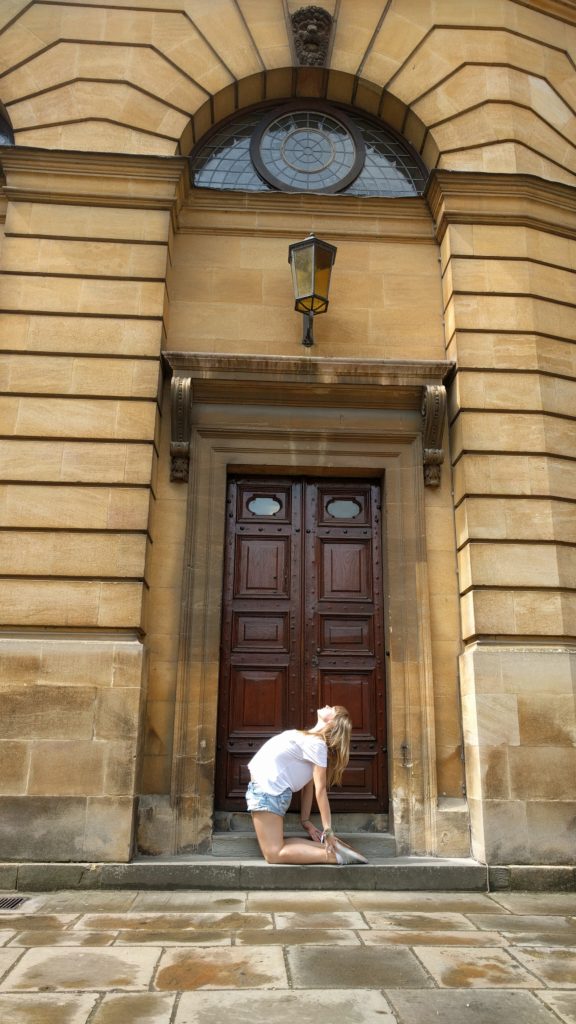Third week and third chakra! Manipura chakra is located in the naval and is known as the solar plexus chakra. When our moola bandha (abdominal lock) and jalandhara bandha (throat lock) are combined it is this chakra which is awakened. The associated colour of this chakra is yellow, its element fire and its inner aspect is opinion and personal power. It is linked to the sun and can be thought to draw solar energy into the body allowing it it to flow to each part through the subtle energy lines or nadis. Physically it also links to a large collection of nerves within the solar plexus. The yoga guru Patanjali states that through control of Manipura full knowledge and mastery of the body are achieved.
Again looking at the yantra is a great way to get a further understanding of this chakra. The manipura yantra is made up of ten petals, a red triangle and a ram and a version of this can be seen above.
Ten petals – these represent the ten pranas or energies
Triangle – the spreading of energy
Ram – represents strength and courage of who we are in the world, like the ram maybe a little headstrong but clear in intention
When the third chakra is in alignment its qualities are clarity, self-confidence, bliss, self-assurance, knowledge, wisdom and the ability to make decisions, just like the ram. Energetically the solar plexus chakra increases our energy reserves which is why we have so much power and feel so fearless when it is in balance. When this chakra is in an excessive chakra balance though it has such qualities as perfectionism, anger, hatred and too much emphasis on power due to the amount of energy that is associated. A lack of self-assurance is also prevalent when there is a Manipura chakra deficiency and human fears about life, death and illness arise.
More physical manifestations of imbalances are linked to the digestive process and assimilation of food and prana (energy). For instance blockages can cause diabetes, digestive disorders, circulatory disease, blood pressure fluctuations and eating disorders. The biggest health issue associated with Manipura chakra though is stress, the large plexus of nerves around this chakra is one of the main regions of the body that reacts to stress, hence why you get that feeling of a knot in your stomach when you are worried about something! It is therefore important to recognise this and try your hardest to remove yourself from the stressful situation, maybe do some breathing exercises go for a long walk or make some changes if it is a more chronic stress situation.


When energy is flowing freely in manipura chakra it constantly supplies balance and strength and therefore core strengtheners such as boat pose can be used to help restore the vitality. Cow face pose is an active asana for manipura chakra stimulating the pancreas and kidneys often linked to diabetes and therefore in the region of the solar plexus. The knee position in cow face pose also directs the energy towards the solar plexus due to their locked state. Ustrasana or camel pose is a passive asana for Manipura chakra directing the energy back down to the core of the body which through this torso opening stretch is open and ready for the energy. Other recommended asanas are downward dog bringing your knee to your nose, high lunge twists, intense side stretch and revolved triangle.
As well as giving you these asanas to bring into your practice I thought I could give a few techniques I have used to combat stress as it is so associated to this chakra. The key to combating stress is beginning to recognise the trigger points before it gets too much to cope with. Maybe try journalling on a daily basis even if its just a few points on how the day has gone, if there’s been stress try and identify why and if there hasn’t been really focus on what’s made you happy that day. I’ve found these really useful clues to go back to regularly to identify my trigger points. The main technique I use while encountering stress though is a pranayama or breathing technique, counted breath, using it to slow my breathing and bring my mind in check. Starting on the inhale count in for four, then exhale for four, use this timing for four or five breaths and then see if you can extend the inhale and exhale count. Maybe even hold for a couple of counts after the inhale if this feels right. This really helps to bring some focus to the mind and bring the body out of its fight or flight mechanism.
Maybe give it a go next time, Namaste

